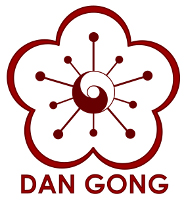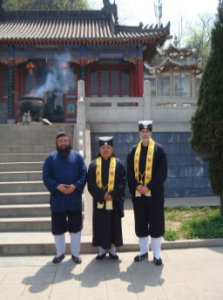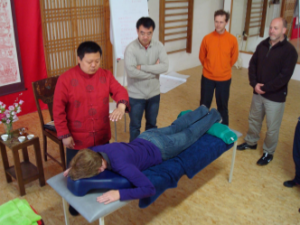Published in Journal of Daoist Studies, Volume 6, 2013
GERHARD MILBRAT & KNUT GOLLENBECK
The Zhongnan mountains 鍾南山, southwest of Xi’an, are a major center of Daoism. Not only do they contain the place where Laozi transmitted the Daode jing, but the area also brought forth the Longmen lineage 龍門派 of the school of Complete Perfection (Quanzhen dao 全真道) with its particular combination of Daoist thought, ways of nourishing life, and internal alchemy. For over a thousand years, wise men, hermits, monks, priests and healers have lived in this Daoist holy land, inspired by its heritage and inspiring their followers.
Master Li Jiacheng 李佳诚, a 22nd generation Longmen Daoist, is one of the key figures there today. Receiving Daoist instruction from childhood, he finds himself increasingly in the public eye, especially in his spread of the esoteric practices of Jin Dan Dao 金丹道(Golden Elixir Daoism). The abbot of a small yet ancient temple called Anle gong 安樂宮 (Palace of Peace and Happiness), his work centers on self‐cultivation, Daoist medicine, especially qigong treatments, and meditation. He is creating a new dimension of Daoist practice today.
The Zhongnan Mountains
Southern Shaanxi is divided east to west by a mountain range approximately a thousand miles long, known as the Qinling range 秦嶺山. Its mountains form a natural barrier and create a watershed between north and south china. Blessed by a rich flora and fauna as well as ample deposits of jade, gold, and other metals and minerals, the peaks reach up to 9000 feet: the main summit is Mount Taibai 太白山 at 11,300 feet (3767 m). The foothills of the Qinling range begin about thirty miles southwest of Xi’an, to rise from there into a lesser range known as the Zhongnan mountains. Ranging for a length of over 150 miles, they contain many Daoist centers and have housed innumerable hermits over the millennia (see Porter 1993)*.
Many important masters lived and practiced here. Laozi transmitted his philosophy here, at Louguantai 樓觀台, on his emigration to the west. Wang Chongyang 王重陽 (1113‐1170), the founder of Complete Perfection, began his ascetic career here before venturing into Shandong to spread his teachings. The Xiyou ji 西遊記 (Journey to the West) has Faxian stop first at the Jinxian guan 金仙觀 (Temple of the Golden Immortal) with its terraces dating back to the Han.
The temple is, moreover, the root location of Korean Daoism: a Korean monk 金可 记 reached immortality here before bringing Daoism to his homeland.
Today Daoism is increasingly popular in China, in the various areas of religion, health enhancement and tourism. Many temples are being restored and expanded. In the Zhongnan mountains, these include especially the Yuquan yuan 玉泉院 (Jade Spring Monastery) at the foot of Mount Hua, the Zongsheng guan 宗聖觀 (Monastery of the Ancestral Sage), occupying several hectares of a new Daoist Culture Area near Longuantai and the Danyang guan 丹陽觀 (Monastery of Ma Danyang), about twenty miles west of Louguantai, where the Complete Perfection master Ma Yu 馬鈺 (aka Danyang; 1123‐1183) worked.
The Chinese government supports this expansion, encouraging Daoist groups to restore historic areas and develop new modern facilities such as spas, hospitals and sanatoria, which increasingly make use of Daoist methods of life cultivation. This overall development is also affecting smaller and lesser known temples.
Among them is particularly the Anle gong, in the early middle ages founded as a Buddhist temple by the name of Baoning si 寶 寧 寺 (Monastery of Treasuring Peace). It became a Daoist temple in the early years of Complete Perfection, when Qiu Chuji 邱處機 (aka Changchun 長 春; 1148‐1227), the senior and most famous of the founder’s disciples, settled nearby on Mount Longmen.
Its name derives from Prince Anle, the third son of emperor Yang Jian 楊堅, the first emperor of Sui Dynasty. After many years of war, wished his son to grow up in “peace and happiness” (anle).
The temple honors all major Chinese religions: its main hall has a stone statue of the Buddha in the center, with Confucius and Lord Lao on his right and left. Surrounded by mountains covered with pine trees and fresh springs, it is a wonderful place for recreation, an inspiring site to leave the world behind and turn toward the eternal path of Dao.
Golden Elixir Practice
The Anle gong today is the home of Li Jiacheng, 22nd master of Longmen lineage. Born in Xi’an in 1964, he spent his entire life in the region, receiving Daoist education since childhood and especially training with Master Zhao Jiaohua 赵教华 in the practice of the Golden Elixir. He has been charged with bringing this practice into the open and making it available to the general public. As part of this effort, Li worked for several decades as a qigong teacher, spreading Daoist practice in China, Korea, Europe and Canada. More recently he, together with Master Ma Fanpu 马钒镨, is explaining his experiences in lectures and systematic teaching, spreading the traditional Jin Dan Dao system with its particular path of internal alchemy more widely in modern society.
Jin Dan Dao training proceeds in three stages, applicable equally to practitioners, patients, therapists and teachers. The basic class serves to build a theoretical and practical foundation, using exercises to purify the Three Treasures (sanbao 三寶: essence, energy, spirit), providing methods for physical well‐being and teaching techniques to enhance life on the psychological and spiritual levels. The second level teaches how to cultivate concentration and enhances spiritual training, focusing on an indepth application of the various exercises and techniques. It also teaches a deeper way of strengthening qi. Level three provides an in‐depth study of the theoretical principles as well as powerful control of the body and its energies; this allows practitioners to awaken their subconscious powers and tune into resonance with the universal origin.
The system works with several qigong exercises which clear, purify, and strengthen qi, then open ways to make this strength easily available on a daily basis. They are all embedded in the traditional concepts of the Longmen lineage.
The initial, preparatory practice is Dantian qigong 丹田 (Elixir Field Practice), a form of sitting meditation which first calms the mind, then calms the heart. After that practitioners take the calm mind‐and‐heart to the lower elixir field and focus it there, imagining it as a golden pill. Here the calm empty mind resides and the qi will gather. This is explained as shen gathering qi and, with time and practice, becoming jing or essence. Since this is the foundation of all other alchemical processes, takes time to consolidate.
The other part of Dantian qigong is standing meditation. This includes small movements to give outer form to the inner guiding, done with hands held before the Dantian and mentally focusing on the Laogong points in the palms of the hands. A connection is felt to the lower Dantian, making the hands more sensitive to energy flow and fields. Other postures focus on the approach to the lower dantian from the back and the top. The main point of the practice is the intention (yi, directed mind connected to spleen) combining with the will (zhi, the mental aspect of the kidneys) and the empty spirit (shen, residing in the heart) to center on the abdomen – in an area that is the largest cavern for the gathering of qi in the lower elixir field. Breathing is natural and regulates itself.
The practice overall serves to increase primordial qi and centers the person’s energy in the lower elixir field. Only when this is strong as the physical and energy center of the person can the meridians be fully flooded with qi. When the reservoir is full, the channels cannot dry out.
First level practice is Yibu gong 一步功 (First Step Practice), a set of standing postures and small movements, which also includes one form of sitting meditation. The practitioners‘ sensitivity is already subtler, with an increased awareness of energy fields and flow. Beginning with emptiness by standing in stillness or Non‐Ultimate (wuji 無極), they intentionally work their qi by shaking the wrists and creating a vibration throughout the whole body in the position of the Great Ultimate (taiji 太 極). The following postures work intentionally release liver‐qi through the eyes and strengthen of the phase earth in the Middle Heater, i.e. the digestive system. The arm movement in these postures simply reflects of the inner movement of the guided qi.
Another step at this stage is to open the Penetrating Vessel from Hundred Meeting (Baihui 百會) at the top of the head to Meeting Yin (Huiyin 會陰) at the pelvic floor through guided imagination. In addition, several postures play with qi.
The deeper meaning of Yibu gong that we intentionally, with the help of our hun 魂 (heavenly soul) let go of selfish, egoistic thoughts. Reflecting the mindset of mind over matter, this signals to the body and the po 魄 (corporeal soul) that we intentionally accept mind and matter working together. Thus, both hun and po find their needs fulfilled – expressed by phrases like “Tiger and Dragon mating“ (longhu jiaohou fa, 龙虎交姤法). Working with postnatal essence (houtian jing 後天精), this allows the qi to flow freely and strengthens the earth aspect in the human being. As practitioners retrieve the “middle,” emotions move into balance and the intention becomes more vigorous. Intention and imagination direct qi. With a strong earth aspect, practitioners can accumulate qi without restraint and their bodies produce ample blood.
As more and more qi fills the lower elixir field and the channels, adepts next undertake Wuxing gong 無形功 (Formless Practice) to clear the organs and fill them with qi. Here practitioners direct the clear mind to the yin and yang organs to enhance their internal awareness. Outer movements are just to bring the hands in front of the respective organ to increase their sensitivity. In this form practitioners work with metaphors regarding the five phases, such as “The dark cold waters of the north fill our kidneys and clean them“, “the eastern breeze refreshes our liver“ etc. This harmonizes the internal processes and enhances the quality of qi. From here it is only a small step to the point when not only the meridians and organs are cleared and filled with energy, but this energy even spills over into the extraordinary vessels.
Higher Levels
From here practitioners proceed to the second level of training, known as Erbu gong 二步功 (Second Step Practice), a set of standing postures with movement of the arms and torso while working with more precision on the inner pathways of qi. They envision an energy line from the third eye (Tianmu 天目 / Yintang 陰堂) on the forehead through the skull and the pituitary gland all the way to the back of the Head, to the ancestral mirror (houtian jing 後天鏡). They also continue working on the Penetrating Vessel, from the head through the throat, the heart, the digestive center, and the lower Dantian all the way to the perineum. This opens the middle and upper elixir fields. It also serves to improve qi accumulation by strengthening the lungs and opens the Governing Vessel that runs along the spine.
This, next, leads to the practice of Xiaozhou tian 小周天(Microcosmic Orbit). Guiding the cleared qi through the Governing and Conception Vessels with conscious attention, practitioners condense and move it between essential energy centers and extraordinary vessels. This is the beginning of true internal alchemy as it begins to work with prenatal (pre‐Heaven) essence.
Once adepts have cultivated this step, moving, leading, and directing qi in the body in different ways, they learn Faqi 發氣 (Releasing Energy) and Caiqi 菜氣 (Absorbing Energy). Releasing energy is done by knowing how to gather qi, guiding it through the body’s pathways, and then projecting it outward through the Laogong 勞宮 points in the palms. Like the other forms, this requires intensive training for two to three hours every day; more specifically, it also involves training to increase sensitivity toward outside energy fields, preferably using a tree. This, in turn leads to the application of qi in different fields, such as life care, medicine, and the martial arts.
On the third level of training adepts learn Kai Tianmu 開天目 (Opening the Heavenly Eye). They compress the golden essence, the golden embryo, or the red pearl. This is the combination of highly clear yang-yi 意 (directed mind/intention), strong zhi 志 (will/volition) and an empty shen 神(intentionless or unselfish mind) – with the most refined yin, i.e., jing 精 (essence) gathered through the various earlier practices. This leads to an integrated body‐mind experience that words cannot do justice to. It leads to a state where practitioners can go beyond ordinary physical limitations. They are able to see or sense deep inside themselves, feel or sense energy in the body of a patient, recognize illness‐causing blockages of qi and feel or sense an opponent‘s intentions before any overt movement during martial arts combat.
A supplementary practice that accompanies the different qi exercises on all levels is Zuogong 坐功 (Sitting Exercises). This includes different kinds of meditations, such as those described above. It is more quiet and meditative than the various standing exercises, which all have a component of strengthening the body. Standing still for an hour will strengthen the legs; holding the arms in a certain position in front of the body strengthens the shoulders and upper body. All standing exercises are done very slow and last at least 15‐30 minutes. Together with the meditations they ultimately lead to oneness with Dao at the origin of all life.
Daoist Medicine
All these exercises are fundamental forms of Daoist cultivation and nourishing life (yangsheng 養生). They form the backbone of the increasingly popular field of Daoist medicine, a way of enhancing health and aliveness for everyone. Practitioners benefit; teachers spread the potency of Dao; therapists apply the exercises’ power and skills; patients release their ailments and suffering.
Master Li works hard to further develop this system and spread it widely, giving lectures at international centers, Chinese medical clinics, Daoist conferences, workshops and symposia. He also takes good care of his Chinese and international master students and acts as a consultant for quality management for the board of several branches of the school‘s organisation in Asia and Europe. More and more therapists, teachers and practitioners are coming to his center and attending his workshops, making this a form of Daoist cultivation that is truly international.
References
* Porter, Bill. 1993. The Road to Heaven: Encounters with Chinese Hermits. San Francisco: Mercury House.







